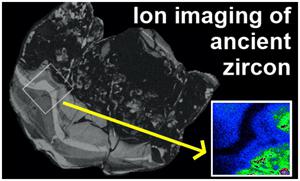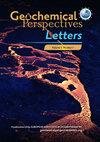古锆石离子成像
IF 3.7
1区 地球科学
Q1 GEOCHEMISTRY & GEOPHYSICS
引用次数: 1
摘要
本文章由计算机程序翻译,如有差异,请以英文原文为准。

Ion imaging of ancient zircon
Analytical methods SIMS U–Pb Sample AC13 was collected by Stephen Moorbath from the University of Oxford in July 1995, from 500 metres NNW of the Acasta camp. Zircon crystals from sample AC13 were analysed for U–Th–Pb isotopes using the SHRIMP II ion probe at Curtin University following standard operating procedures (Wingate and Kirkland, 2014). The zircon surface was sputtered with a primary, mass-filtered (O2) − beam with ~ 2 nA current, focused to a ~ 15 μm spot. The mass resolution, M/ΔM, was better than 5000. Twenty-two analyses of the 91500 zircon reference material (Wiedenbeck et al., 1995) were obtained during the session, all of which indicate an external spot-to-spot (reproducibility) uncertainty of 1.33% (1σ) and a U/Pb calibration uncertainty of 0.45% (1σ). These calibration uncertainties are included in the calculated uncertainties on U/Pb* ratios and dates listed in Table S1. The OG1 zircon reference material was analysed as an unknown and yielded a weighted mean Pb/Pb age of 3458 ± 7 Ma (MSWD = 0.51, n = 5), within accepted values (Stern et al., 2009). No fractionation correction on Pb/Pb was deemed necessary. Common-Pb corrections were applied to all analyses using contemporaneous common Pb determined according to the model of Stacey and Kramers (1975) based on Pb counts. The Excel-based program Squid 2 (Ludwig, 2001) was used for data processing and data were plotted using Isoplot (Ludwig, 2003).
求助全文
通过发布文献求助,成功后即可免费获取论文全文。
去求助
来源期刊

Geochemical Perspectives Letters
Earth and Planetary Sciences-Geochemistry and Petrology
CiteScore
7.00
自引率
2.00%
发文量
42
审稿时长
15 weeks
期刊介绍:
Geochemical Perspectives Letters is an open access, internationally peer-reviewed journal of the European Association of Geochemistry (EAG) that publishes short, highest-quality articles spanning geochemical sciences. The journal aims at rapid publication of the most novel research in geochemistry with a focus on outstanding quality, international importance, originality, and stimulating new developments across the vast array of geochemical disciplines.
 求助内容:
求助内容: 应助结果提醒方式:
应助结果提醒方式:


